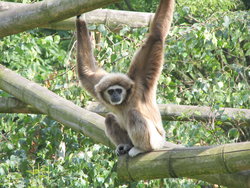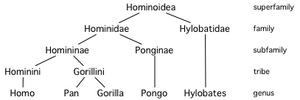Ape
Apes are the members of the Hominoidea superfamily of primates, including humans. Currently, there are two families of hominoids: more...
- the family Hylobatidae consists of 4 genera and 12 species of gibbons, including the Lar Gibbon and the Siamang, collectively known as the "lesser apes"
- the family Hominidae consisting of gorillas, chimpanzees, orangutans, and humans, collectively known as the "great apes".
A few other primates have the word "ape" in their name, but they are not regarded as true apes.
Except for gorillas and humans, all true apes are agile climbers of trees. They are best described as omnivorous, their diet consisting of fruit, grass seeds, and in most cases some quantities of meat and invertebrates—either hunted or scavenged—along with anything else available and easily digested. They are native to Africa and Asia, although humans have spread to all parts of the world.
Most non-human ape species are rare or endangered. The chief threat to most of the endangered species is loss of tropical rainforest habitat, though some populations are further imperiled by hunting for bushmeat.
Historical and modern terminology
"Ape" (Old Eng. apa; Dutch aap; Old Ger. affo; Welsh epa; Old Czech op) is a word of uncertain origin and is possibly an imitation of the animal's chatter. The term has a history of rather imprecise usage. Its earliest meaning was a tailless (and therefore exceptionally human-like) non-human primate, but as zoological knowledge developed it became clear that taillessness occurred in a number of different and otherwise unrelated species.
The original usage of "ape" in English may have referred to the baboon, an African monkey. Two tailless species of macaque are commonly named as apes, the Barbary Ape of North Africa (introduced into Gibraltar), Macaca sylvanus, and the Sulawesi Black Ape or Celebes Crested Macaque, M. nigra.
Until a handful of decades ago, humans were thought to be distinctly set apart from the other apes (even from the other great apes), so much so that many people still don't think of the term "apes" to include humans at all. However, it is not accurate to think of apes in a biological sense without considering humans to be included. The terms "non-human apes" or "non-human great apes" is used with increasing frequency to show the relationship of humans to apes while yet talking only about the non-human species.
Biology
The gibbon family, Hylobatidae, is composed of thirteen medium-sized species. Their major distinction are their long arms which they use to brachiate through the trees. As an evolutionary adaption to this arboreal lifestyle, their wrists are ball and socket joints. The largest of the gibbons, the Siamang weighs up to 23 kg. In comparison, the smallest great ape is the Common Chimpanzee at a modest 40 to 65 kg.
Read more at Wikipedia.org


